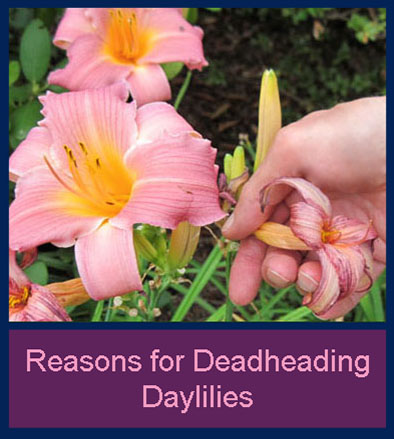Should I Deadhead Daylilies?
Daylily care deadheading daylilies is a form of pruning daylilies, which involves removing the whole flower including any developing seedpods after the daylily flower petals have died. This is important for some reblooming perennials although often recommended for daylilies. There are several reasons given for deadheading daylilies, you need to decide for yourself whether it is worth the effort, or if you have the time, trimming spent daylily flowers can be a relaxing pastime.
Appearance is usually the main reason for deadheading. As most gardeners know, flowers on a daylily only last a day, and in the morning the faded flowers from the previous day are still attached to the daylily scape or the main flower stem. The daylily blooms will often drop off on their own after a few days, but it depends upon the daylily cultivar and the weather. In humid or damp conditions especially, the petals of spent blooms can stick to new daylily flowers and discolour them or prevent the daylilies from opening properly. Pruning daylilies will enhance the display of new blooms and give a much tidier appearance.
Remove the developing seed pods is the next reason given for deadheading daylilies, this is so the plants will put energy and resources into producing more new flowers, rather than seeds. Initially, you may find it easier to use scissors or secateurs to cut off the old flowers this can be a little slower at first but with practice, you can master deadheading flowers quickly, most people find it easier to pinch or snap off the flower with their fingers just like the picture shows.
The amount of energy used in seed development is usually not significant in a healthy plant and the plant should be able to replace that energy easily in time for the next year’s flowering. Adequate water, especially during a hot dry summer in Australia and regular division of large daylily clumps are both far more important in increasing flowering than deadheading, even for the yellow so called rebloomers such as Stella de Oro. It may, however, encourage new flowering scapes to form more quickly on a rebloomer, if you cut off the old scape down at the base of the daylily plant as soon as all the flowers have blossomed.
Prevent self seeding is another reason for deadheading daylilies this is done by removing pods before the seeds ripen will prevent self seeding, which is more likely to be a problem with old cultivars, and many daylilies set seed on their own with natures help. However, self sown daylilies are not considered a serious environmental weed in Australia and small seedlings around the parent plant are easy to remove. Seedlings will be different from the parents and some gardeners like to wait and see what type of flowers they produce.
Deadhead to Control pests and diseases as daylily gall midges can lay their eggs in developing flower buds, which this means the flower may not open properly. This is more likely in early flowering varieties. If you notice flowers are not opening, or if developing seed pods appear distorted; cut the pods open and check for signs of larval damage inside. If your daylilies are infected you should remove all infected flowers, buds and seed pods immediately and take away and burn or freeze the infected material. If you do this before the new midges grow wings you should be able to control the infestation and prevent the gall midges infesting later flowering cultivars. Deadheading may also help control other pests such as snails, slugs, aphids and fungal diseases, by reducing the amount of litter on and around the daylily clumps.
Make sure you label the flowers that you have pollinated if you decide you still want to save seeds, leave the old flowers on one or more healthy plants for a few days. If the ovary at the base of the flower stays green and starts to swell the flower was successfully pollinated. It is often a good idea to tie a label the pods you are keeping as a reminder not to take off those pods next time you deadhead your daylilies. Leave the daylily seed pods on the plant to mature until they are brown and dry and starting to split out.
How to deadhead a daylily
Deadheading daylilies is a quick simple process; although it takes time because of the sheer number of flowers produced. Deadheading daylilies is usually done every second or third day by snapping the spent flowers off. The aim is to remove the whole flower, including any developing pod, near or where the flower stem is attached to the scape.
If you enjoy pottering in the garden, deadheading daylilies can be a very enjoyable and relaxing time, giving you an opportunity to admire and appreciate your daylily flowers close up. Deadheading daylilies will certainly give your garden a much fresher cleaner display of flowers. If your time is limited just remove old flowering scapes by deadheading daylilies as soon as the flowers have finished. Deadheading daylilies, pruning daylilies, deadhead daylilies, prune daylilies, clip, trim, cut, thin, lop, crop, snip, cut, shave, shear, shorten, dock, eliminate, exclude, reduce, pinching, shape daylilies.


Comments
Pingback: Caring For Daylilies All Year Long - Daylilies in Australia